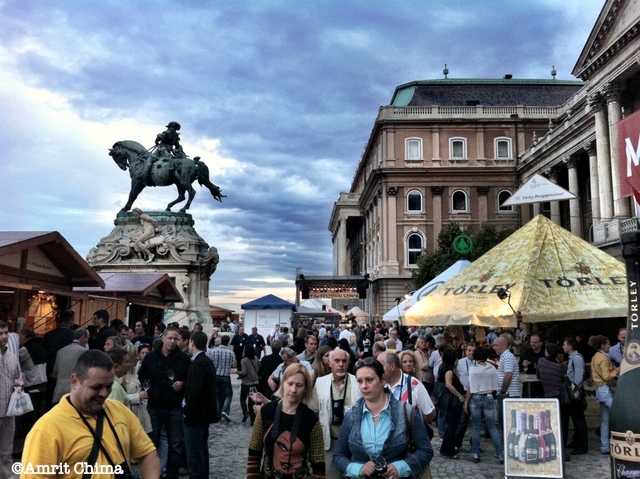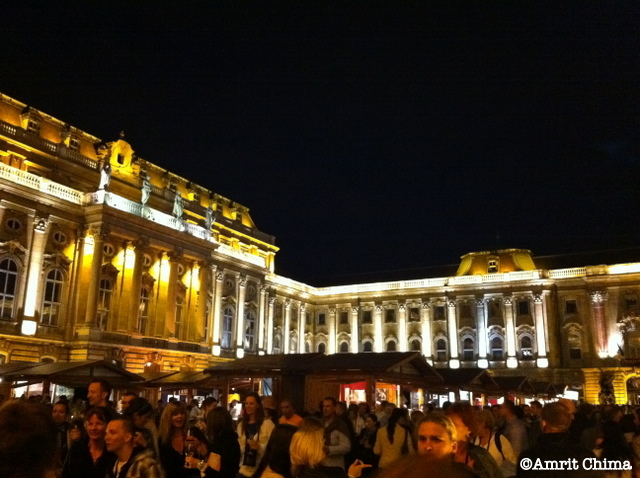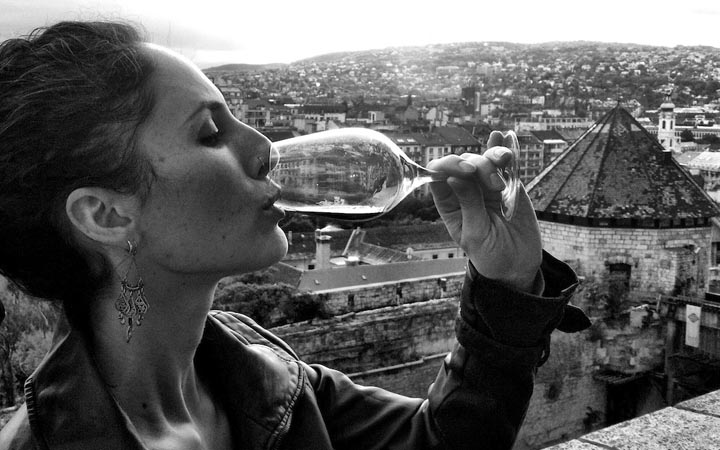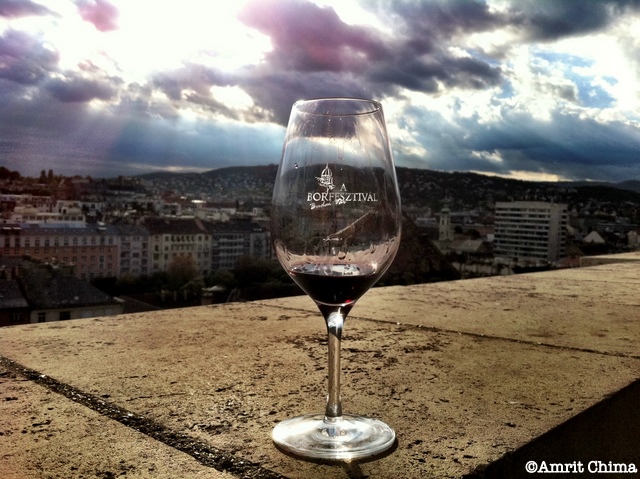Tasting wines at the Budavári Borfesztivál (wine festival) in Budai Vár (the castle on the Buda side of Budapest)
In the days leading up to the yearly Budavári Borfesztivál (a Hungarian wine festival), the buzz of excitement and anticipation sparked a major inquiry around Budapest: “What kind of wines do you like? Cab or Chardonnay?” In other words, do you like red or white? For many novice wine drinkers—and not just in Hungary—it seems to me that wine is merely an idea. It’s a stocked cabinet, a shiny display of quantity for when guests come over. It’s a sense of status, as if the exorbitant amount spent on a bottle—which doesn’t necessarily mean it’s good—defines the very essence of a person’s sophistication. And sometimes wine signifies pride in one’s culture, which is a far cry from actual knowledge. I know one gentleman who quite regularly—and vehemently—maintains that the wines of his country are the world’s absolute supreme. He insists on this point without flinching, without a trace of self-consciousness despite the fact that he pours raspberry syrup into Dom Pérignon.
The question of red or white, I now know after beginning my wine education in Austria, is intensely limited. What types of wines I like to drink depends on a number of variables. The more I learn, the more particular I have become about what I drink and when. It’s not simply about the intrinsic balance of the wine itself, the importance of which I discovered during my first serious tastings. External factors are equally as important. It matters now if it’s cold out, or hot, or if it’s raining, if I’m reading a book, or what dish I’m eating.
To further my education—and to continue on my quest for quality wines—I attended Hungary’s wine festival, which takes place up in the Buda castle overlooking the Danube and all of Pest. Throngs gathered in the outside courtyards, listening to live Dixieland jazz, leaning against princely statues, and swarming the trendiest winemakers’ booths for a taste of their country. These people were here for some no-nonsense drinking. There were no spittoons. Pour buckets were usually empty. Very few seemed to actually be sampling. It appeared as though the majority of the crowd preferred full glasses, purchasing without discernment.
 Budadvári Borfesztivál at dusk
Budadvári Borfesztivál at dusk
 Wine Festival in Budai Vár after nightfall
Wine Festival in Budai Vár after nightfall
These empty pour buckets illustrated that despite a growing fashionableness, wine here is not yet a staple of culture. Russian communism ended only twenty years ago. Now, as an independent nation producing—and learning to taste—wines, there simply hasn’t been time to elevate the quality or to heighten the education. It therefore required a bit of digging to find what best suited my palate. But, after meandering through the maze of booths and crowds, I managed to discover several good wines, two of which made an impression.
Malatinszky Vineyards are situated in the rolling slopes of Villány, Hungary’s region best distinguished for its red varietals. Winemakers commonly filter their wines to create a clearer, more stable liquid. Csaba Malatinszky, however, foregoes this process while bottling some of his wines in order to better preserve their true essence. Filtering is suspected to remove elements that affect taste and nose, stripping the wine of important characteristics. Though still a bit young, his light-to-medium-bodied unfiltered Cabernet Franc had an intense mineral flavor that I found unusual but enjoyable, as well as a high concentration of tannins.
Although Hungary is not internationally recognized for its wines—most stay exclusively within the country, made, sold and bought by locals—several produced in the dessert-wine region of Tokaj have a healthy and well-deserved reputation abroad. Those from Oremus Vineyards were by far the most complex I tasted.
The Oremus winemaker’s skill with the aszú grape, which flourishes in this area of the country, is what sets this vineyard apart. The concentrated dessert wine these grapes produce is the result of a condition known as noble rot, in which the grapes become partially raisined on the vine. After each is individually picked, the full harvest is then crushed into a paste and combined with a non-aszú wine made from a mixture of other varietals, such as Furmint or Muscat Blanc à Petits Grains. It is then left to ferment. The resulting dessert wine is intricately nuanced. As Szabolcs Ujfalussy, Oremus’s representative at the festival, aptly described it, “These wines are so nicely balanced that at the end of a meal, even when you’re full, it can still refresh you.” Their acidity makes them stimulating rather than simply heavy and syrupy.
In this freer, new age of independence—as Hungary endeavors to hone its winemaking expertise—a blossoming of wine culture is taking place, as illustrated by the popularity of the Budavári Borfesztivál. The only problem I foresee is a continued isolation from the rest of the world. Not only does Hungary not export much of their production, but they also don’t import much. Without greater exposure to wines of other cultures there is no basis for comparison, and increased quality of Hungarian wines will likely be inhibited. Still, for as long as I live here, I will continue my search, trying new vineyards and varietals, determined to find the perfect Hungarian bottle.







